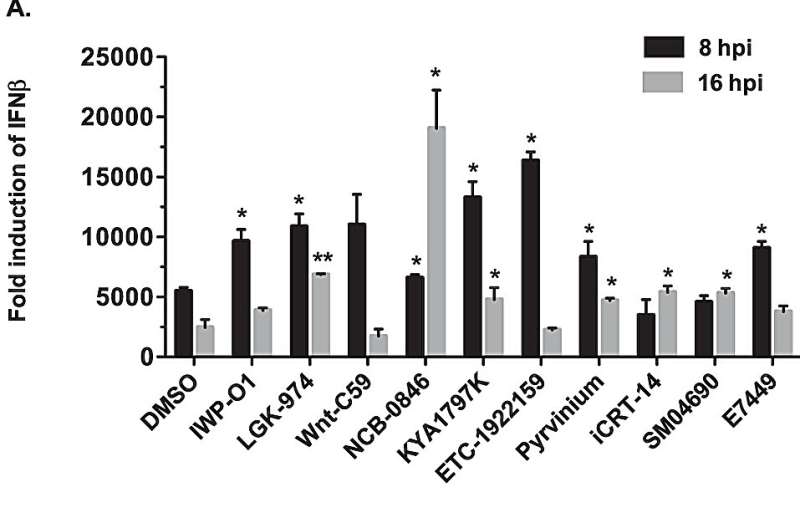This article has been reviewed according to Science X's editorial process and policies. Editors have highlighted the following attributes while ensuring the content's credibility:
fact-checked
trusted source
proofread
New class of antivirals works against broad range of RNA viruses including SARS-CoV-2

A University of Alberta research team has uncovered a new class of drugs with the potential to prevent or treat infections in a future viral outbreak.
In research newly published in npj Viruses, the team reports that SARS-CoV-2, the virus that causes COVID-19, activates a pathway in cells that stops the production of peroxisomes and interferon, key parts of the normal immune response. The team successfully tested drugs that stimulate interferon production to reverse that effect, thereby identifying a new class of drugs with antiviral action.
"Interferon does two things that result in the inability of an infected cell to produce more virus," explains principal investigator Tom Hobman, professor of cell biology and adjunct professor in medical microbiology and immunology in the Faculty of Medicine & Dentistry, and a member of the Li Ka Shing Institute of Virology. "It shuts down the infected cell, often resulting in cell death, and it also acts on the surrounding cells to prevent them from being infected."
The paper builds on earlier research from the team that revealed how HIV has evolved to activate the Wnt/β-catenin signaling pathway, likely as a way to stop the body from producing peroxisomes, which would normally then trigger interferon production. The research team posited that SARS-CoV-2, another RNA virus, would act in the same way to counteract the body's antiviral response.
The team tried 40 existing drugs that target the Wnt/β-catenin signaling pathway. Most were originally developed and tested for treating cancer, which often responds to boosted interferon production. Of the 40 drugs tested, 10 that were most effective in reducing viral load were chosen for further study. Three were eventually studied in mice infected with severe COVID-19. The drugs significantly reduced the amount of virus found in the lungs, and one of the drugs was also effective at reducing inflammation and other clinical symptoms in the mice.
"Sure enough, these drugs did increase the number of peroxisomes and they also enhanced the interferon response, so we would get four or five or six times as much interferon produced in response to a viral infection," says Hobman. "We saw, in some cases, a 10,000-fold reduction in the amount of virus produced in a test tube, and when we went into a mouse model, the drugs prevented severe weight loss and the mice recovered much quicker."
Hobman notes that others have tried using interferon as a treatment for COVID-19 but its use is limited because it must be taken intravenously in hospital. It is also very important to time the interferon to avoid making the patient even sicker.
"What we know about coronavirus infections is that if patients develop a robust interferon response early in the viral disease, the viral load goes down, they clear the infection and the inflammation is limited," he explains. "However, if the interferon response is delayed or muted, the viral load goes way up and you get a lot more inflammation. That's where people get into trouble."
The new antiviral interferon treatments would potentially be given as a nasal spray or a pill, Hobman says. During a viral outbreak, people who might have been exposed or who have already developed early symptoms would take a four- or five-day course to prime their peroxisome levels and limit the severity and spread of the disease. Few side-effects would be expected from such a short course of treatment.
"The beauty of this approach is that in the absence of viral infection, there's no interferon produced," Hobman says. "We see these drugs potentially serving as first-line drugs against emerging viruses."
Three members of the research team, including Hobman, have a U.S. patent pending on the approach. They have tested it against other coronaviruses as well as Zika, Mayaro and influenza viruses, and the results indicate these drugs are active against a wide spectrum of viruses. The team is now performing pre-clinical testing to identify the best drug and dose, and is seeking a new pharmaceutical partner to carry out clinical trials.
More information: Zaikun Xu et al, The Wnt/β-catenin pathway is important for replication of SARS-CoV-2 and other pathogenic RNA viruses, npj Viruses (2024). DOI: 10.1038/s44298-024-00018-4





















